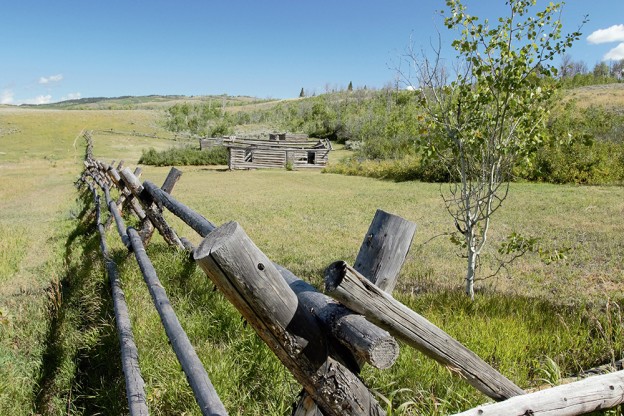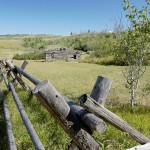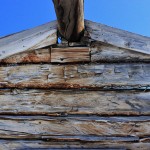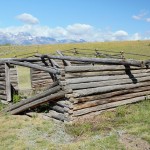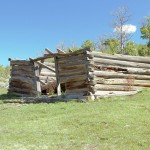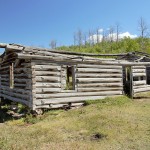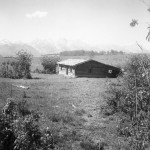- Luther Taylor homestead. Photo by Samantha Ford
- Ax marks are visible that made the interior logs flat for wallpaper to be applied. Photo by Samantha Ford
- John Erwin’s cabin and Luther Taylor’s barn. Photo by Samantha Ford
- John Erwin’s barn, Luther Taylor’s chicken coop. Photo by Samantha Ford
- Luther Taylor’s cabin. Photo by Samantha Ford
- Luther Taylor homestead. Collection of the Jackson Hole Historical Society and Museum
- Luther Taylor homestead. Collection of the Jackson Hole Historical Society and Museum
In 1910, John Erwin first arrived in Jackson Hole and filed for 160 acres on the eastern side of the valley, just north of the community of Kelly. Located on the Gros Ventre Road, the property is a popular tourist destination today for its association with the western movie Shane. Known more often as the “Shane cabins,” the actual homesteading history of the property is often forgotten. John Erwin arrived in the valley from Wisconsin, seeking the prospect of free lands offered by the federal government. These lands were previously unavailable due to their location in the Teton National Forest, but in 1908, President Roosevelt opened them up for homesteading.
Just six years after establishing residency in 1916, Erwin was approved for 160 acres. He lived on the property with his son, daughter and son-in-law. Unfortunately he would die in the next four years, and his family sold the property in pieces: 40 acres were sold to Luther Taylor in 1923 that included two buildings that had been constructed by Erwin. The barn and a small one-room cabin were likely built in 1910 when Erwin first arrived. Today, the one-room cabin is known as the barn. Taylor built his own three-room cabin, probably in 1923. It is assumed that the remaining 120 acres were included in adjacent holdings by Erwin’s family for agricultural purposes. In 1927, feeling the pressure of owning only 40 acres of land, Taylor filed for his own 160 acre parcel, increasing his homestead to 200 acres.
Luther Taylor had been residing in the valley since 1908 when he first arrived with his parents and siblings. They hailed from Arkansas, where Taylor was born in 1891. As a farming family, they saw the offer of free land in Jackson Hole as a promising venture. The Taylor family homesteaded in the area north of John Erwin’s, and south of Ditch Creek Road. The Taylors held 200 acres between William, Luther’s father who had 40, and Luther’s brother John, who had 160. Luther would earn a living working on his brother’s ranch until he left the valley to fight in World War I. Upon returning home after the war, Luther assumed management of his late father’s holdings and married Agnes Smith in 1920. In 1922 they had their first daughter, Dorothy. They left William Taylor’s ranch after purchasing the John Erwin homestead in 1923. These lands were adjacent to Luther’s brother John, and it is likely the brothers assisted each other with ranching on their joint lands. At this time the Taylor brothers managed a total of 400 acres.
The only remaining buildings from the Taylor ranches today are those built on the 40 acres Luther purchased from John Erwin. These are significant for being the oldest intact original homestead in the valley. Most homesteads changed significantly as families grew and more time and money could be allotted to constructing more substantial structures. At the Luther Taylor ranch, however, the original buildings constructed by Erwin were preserved and continued to be used by the Taylors. Luther constructed his own three-room cabin to be used as a residence for his family. His craftsmanship and attention to detail is highly unusual, he clearly intended this cabin to be permanent and not be replaced at a later date. It is also probable that he developed cabin-building skills while working on his father’s and brother’s ranches to as the buildings careful lay out and construction indicate a high level of craftsmanship.
The cabin was constructed on a dry laid stone foundation, an unusual step at a time when most cabins were built directly onto dirt floors. The cabin was also constructed on a slope to ensure Teton views, which required the stone foundation for support. The slope that was chosen as the cabin site would have made interior living impossible without floor joists and floor boards. It is clear that Taylor’s cabin building skills were well beyond those of the average homesteader, who would not have been able to select a site that demanded specialized skills needed to make it work. Other evidence of Luther’s skilled craftsmanship can be seen in the interior walls, which were planed with an ax to make them smooth, then covered with newspapers for insulation before being whitewashed. The whitewashing and wallpaper have long been replaced by a weathered patina, but the ax marks are still visible.
In 1931, Taylor lost his wife Agnes in childbirth and was left with three young children that required more care than he could give. He hired Lena Mae, a housekeeper from Salt Lake City to live on the ranch. She brought her own child and lived with Taylor and his children on the ranch until he sold it to Andy and Roy Chambers in 1948. At this time Taylor and Mae married, retiring from ranching to live in Jackson. Five years prior, in 1943, Taylor sold the north 160 acres that had adjoined his brother’s ranch to Gerrit Hardeman. The Hardemans were well known in the valley for their high quality Hereford cattle. They had homesteaded nearby and had begun to increase their holdings. They would later sell their lands to the Snake River Land Company and settle on a ranch in Wilson.
After the Chambers acquired the 40 acre Taylor property, they rented out the cabins for several years to bring in extra cash. In 1951 they are approached by Paramount Pictures to see if the Taylor cabins could be used as a set in the upcoming western, Shane. The Chambers agreed, and allowed the film crew the use of the cabins. Very little changes or alterations were made to the homestead, continuing to preserve its original appearance. While the scene that depicts this cabin was brief, many western movie enthusiasts still seek it out today. Many mistakenly believe that the cabins were constructed for the movie.
In 1956, the cabins were sold to the National Park Service along with the main Chambers property on Mormon Row. The cabins have been unused and allowed to weather the elements without maintenance since this time. Their significance is due to their unchanged appearance; they remain as they were originally constructed. No major alterations or additions were made to the buildings, despite the barn and chicken coop being 105 years old. Because of their continued preservation, the buildings are able to convey a sense of what the earlier homesteads in the valley would have looked like. Most were haphazardly built, with dirt floors and sod roofs. Despite the severe deterioration of the site from over 65 years of neglect, the cabins still maintain their historic integrity and are one of the most important historic sites in Grand Teton National Park.
TIMELINE
1910: John Erwin establishes his homestead and begins to build cabins and clear the land.
1916-20: John Erwin dies.
1923: 40 acres of the Erwin homestead, including a barn and chicken shed that was used as a one-room residence by Erwin are sold to Luther Taylor.
1927: Taylor files for 160 acres of adjacent land, increasing his holdings to 200 acres.
1931: Taylor’s wife, Agnes dies. Taylor arranges for Lena Mae, a hired housekeeper from Salt Lake City to help him raise his young children.
1943: Taylor sells the adjoining 160 acres to Gerrit Hardeman. The Hardemans are well known in the valley for their prime Hereford cattle.
1948: Taylor sells the remaining 40 acres and his residence along with the two Erwin structures to Andy Chambers. The Chambers lease out the cabin for several years.
1951: With the cabins standing unused, the Chambers family allows Paramount Pictures to use the cabins for the movie Shane.
1956: The Chambers sell the property to the National Park Service and the cabins remain unused and fall into disrepair.
2015: The three cabins still remain on the property but in a state of severe deterioration. The roofs have caved in and the walls are beginning to fail. However, the site is historically significant to the valley, as the oldest intact original homestead.
Text by Samantha Ford, Director of Historical Research and Outreach



